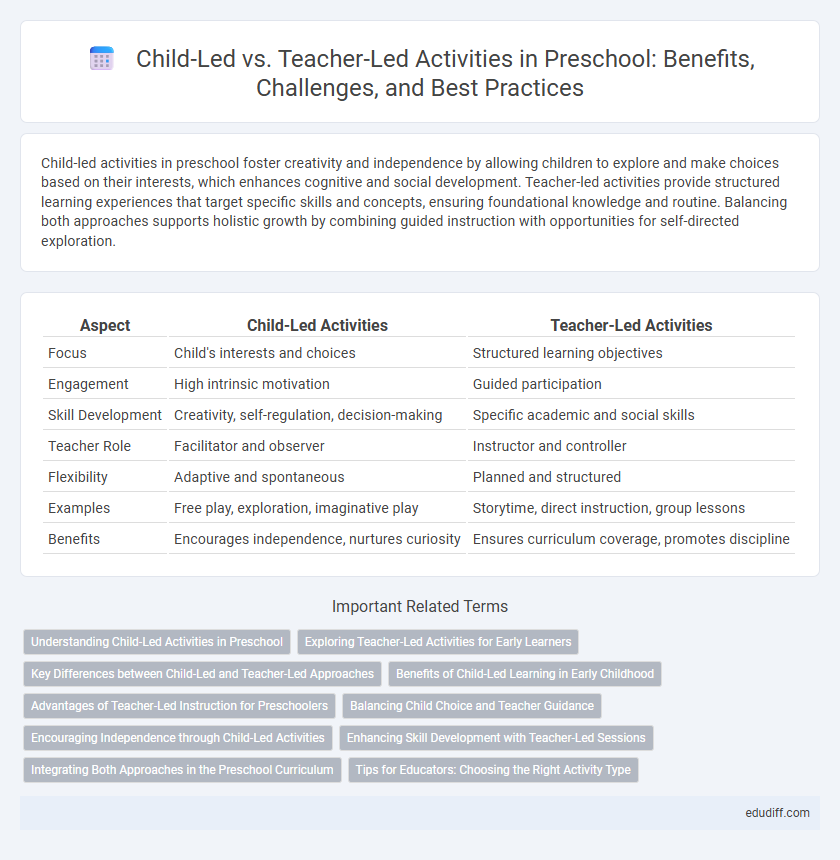Child-led activities in preschool foster creativity and independence by allowing children to explore and make choices based on their interests, which enhances cognitive and social development. Teacher-led activities provide structured learning experiences that target specific skills and concepts, ensuring foundational knowledge and routine. Balancing both approaches supports holistic growth by combining guided instruction with opportunities for self-directed exploration.
Table of Comparison
| Aspect | Child-Led Activities | Teacher-Led Activities |
|---|---|---|
| Focus | Child's interests and choices | Structured learning objectives |
| Engagement | High intrinsic motivation | Guided participation |
| Skill Development | Creativity, self-regulation, decision-making | Specific academic and social skills |
| Teacher Role | Facilitator and observer | Instructor and controller |
| Flexibility | Adaptive and spontaneous | Planned and structured |
| Examples | Free play, exploration, imaginative play | Storytime, direct instruction, group lessons |
| Benefits | Encourages independence, nurtures curiosity | Ensures curriculum coverage, promotes discipline |
Understanding Child-Led Activities in Preschool
Child-led activities in preschool prioritize the child's interests and pace, fostering creativity, critical thinking, and autonomous learning. These activities empower children to explore their environment, make decisions, and develop social skills through natural interactions. Research shows that child-led learning enhances motivation and supports cognitive and emotional development by allowing personalized engagement with educational materials.
Exploring Teacher-Led Activities for Early Learners
Teacher-led activities in preschool provide structured learning experiences that support early cognitive and social development, fostering essential skills such as literacy, numeracy, and fine motor coordination. These activities leverage the guidance of experienced educators to introduce concepts systematically, ensuring consistent reinforcement and personalized feedback. Incorporating visual aids, interactive storytelling, and hands-on experiments enhances engagement and facilitates deeper understanding in early learners.
Key Differences between Child-Led and Teacher-Led Approaches
Child-led activities in preschool emphasize autonomy, allowing children to explore interests and develop creativity through self-directed play, promoting intrinsic motivation and individualized learning paces. Teacher-led activities prioritize structured guidance, with educators designing specific tasks to achieve targeted developmental goals, ensuring consistency and alignment with curriculum standards. The key difference lies in the balance between fostering independence in child-led approaches and providing authoritative instruction in teacher-led methods to support cognitive and social growth.
Benefits of Child-Led Learning in Early Childhood
Child-led learning in early childhood fosters creativity, independence, and critical thinking by allowing children to explore interests at their own pace, which enhances cognitive and social development. Research shows that child-led activities promote intrinsic motivation and improve problem-solving skills compared to teacher-led instruction. Incorporating play-based, child-initiated tasks supports emotional regulation and builds a strong foundation for lifelong learning in preschool settings.
Advantages of Teacher-Led Instruction for Preschoolers
Teacher-led instruction in preschool enhances foundational skills by providing structured learning environments tailored to developmental milestones, ensuring consistent progress in literacy and numeracy. It facilitates focused group activities that promote social interaction and classroom discipline, essential for early childhood education. Trained educators use targeted teaching strategies that adapt to individual needs, fostering cognitive growth and readiness for primary school.
Balancing Child Choice and Teacher Guidance
Balancing child choice and teacher guidance in preschool settings enhances developmental outcomes by integrating child-led activities that foster creativity and autonomy with teacher-led activities that provide structure and targeted skill development. Research shows that combining both approaches supports social-emotional growth and cognitive skills, as children benefit from freely exploring interests under the scaffold of adult expertise. Effective early childhood education models, such as the Reggio Emilia and Montessori methods, exemplify this balance, emphasizing responsive teaching that adapts to individual children's needs and promotes active engagement.
Encouraging Independence through Child-Led Activities
Child-led activities in preschool settings foster independence by allowing children to explore interests at their own pace, enhancing decision-making and problem-solving skills. These activities support intrinsic motivation and creativity, contributing to stronger self-regulation and confidence compared to teacher-led instruction. Research indicates that child-led learning environments promote autonomy and engagement, essential for early childhood development.
Enhancing Skill Development with Teacher-Led Sessions
Teacher-led activities in preschool provide structured opportunities that target specific skill development such as fine motor skills, language acquisition, and cognitive abilities. These guided sessions offer consistent routines and expert feedback, ensuring children build foundational competencies efficiently and confidently. Emphasizing teacher-led instruction enhances early literacy, numeracy, and social skills critical for school readiness.
Integrating Both Approaches in the Preschool Curriculum
Integrating child-led and teacher-led activities in the preschool curriculum enhances early childhood development by balancing autonomy with guided learning. Child-led activities foster creativity, problem-solving, and social skills, while teacher-led activities ensure foundational knowledge and structured skill-building. Combining these approaches creates a comprehensive learning environment that supports diverse learning styles and developmental milestones.
Tips for Educators: Choosing the Right Activity Type
Educators should assess individual child interests and developmental stages when selecting between child-led and teacher-led activities to foster engagement and learning effectiveness. Combining observational insights with curriculum goals ensures activities support cognitive, social, and emotional growth. Prioritizing flexibility allows educators to adapt and balance structured guidance with opportunities for autonomous exploration.
Child-led activities vs Teacher-led activities Infographic

 edudiff.com
edudiff.com